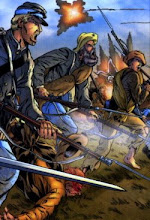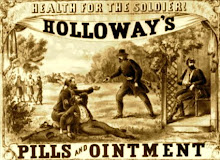Front and back cover from Cleburne
Despite living in Japan where manga are everywhere, on every subject, and read by young and old alike, I'm not much of a comic book fan.
Of course I read a lot of them as a kid, and in particular I enjoyed the old Classic Comics based on famous work of literature, and I used to just eat up the old "Look and Learn" comics from way back in the sixties or so. But after "growing up (?)", I never really found myself attracted to the genre. Superheroes were not my bag and I have had pretty much zero interest in fantasy.
But I do love history and have long had a fascination with the ACW, and in the career of General Cleburne himself. And I did enjoy the movie 300- itself based on a "graphic novel" (the preferred term it seems these days- thought they still look like comic books to me!), so when I saw the following YouTube trailer for Cleburne, I thought it may be worth getting hold of a copy. And I did! It just arrived here his past weekend.
Authored by Justin Murphy, Cleburne tells (obviously!) the story of Patrick Ronayne Cleburne, the Protestant Irish ex-British army corporal from Cork who came to be known as the "Stonewall Jackson of the West". Set in 1863 and '64, when things started really started going south for the CSA, (pardon the pun) the book focuses on Cleburne's efforts to persuade the Richmond authorities to let slaves fight for the Confederacy as soldiers in exchange for their freedom, and of the hot water he subsequently found himself in.
While he looks squarely at the issue of prejudice and slavery in the ACW, one of the main points the writer wanted to emphasize is that the issue of States Rights was a bigger one than was the retention of slavery per se, and that there were those in the South- Cleburne included- who recognized this. Murphy points his finger at the vested interests of the plantation owners, whose short-sighted prejudiced and racist attitudes are epitomized in the novel by the character of General Bate.
While it is clear that slavery was not the only issue of the south, I still feel that it was an important one. Despite efforts to downplay it's significance in some modern writing from a Southern perspective, I cannot help feeling from my reading that at the very least, slavery had become the symbolic issue of states rights, right up until near the very end when it all became academic anyway.
Pat Cleburne was very much in the minority. There was no great desire in the South to eradicate the institution. The need to preserve slavery (i.e. their investments) seems to have been an attitude certainly held by- but no means restricted to- the plantation owners and other powers-that-be.
This was despite the damage that hanging on to such a discredited institution was doing to "The Cause" by preventing any chance of international recognition and legitimacy. Simply put, they were out of step with the times; even Russia had freed the Serfs by 1862. This was not just an attitude held by the wealthy plantation owners; non-slave owners did not have any desire to see armed blacks serving in the army, either no matter how much more manpower it would have given the Confederacy.
But of course the book is also about Cleburne's hard-fighting division in the declining days of the Army of Tennessee, from Ringgold Gap and Kennesaw Mountain to the Battle of Franklin, where Cleburne met his death. It also follows his doomed relationship with Sarah Tarleton.
All in all, a good, well-illustrated comic (and "graphic" indeed- lots of blood, intestines and grey matter being sprayed about as troops charge gun batteries does not make this one for sensitive kiddies). As the author hopes, it may well make for a good movie at some time in the future.
Pat Cleburne was very much in the minority. There was no great desire in the South to eradicate the institution. The need to preserve slavery (i.e. their investments) seems to have been an attitude certainly held by- but no means restricted to- the plantation owners and other powers-that-be.
This was despite the damage that hanging on to such a discredited institution was doing to "The Cause" by preventing any chance of international recognition and legitimacy. Simply put, they were out of step with the times; even Russia had freed the Serfs by 1862. This was not just an attitude held by the wealthy plantation owners; non-slave owners did not have any desire to see armed blacks serving in the army, either no matter how much more manpower it would have given the Confederacy.
But of course the book is also about Cleburne's hard-fighting division in the declining days of the Army of Tennessee, from Ringgold Gap and Kennesaw Mountain to the Battle of Franklin, where Cleburne met his death. It also follows his doomed relationship with Sarah Tarleton.
All in all, a good, well-illustrated comic (and "graphic" indeed- lots of blood, intestines and grey matter being sprayed about as troops charge gun batteries does not make this one for sensitive kiddies). As the author hopes, it may well make for a good movie at some time in the future.
I believe it was Lincoln himself who was supposed to have said; "People who like this kind of thing, will find this the kind of thing they like".










